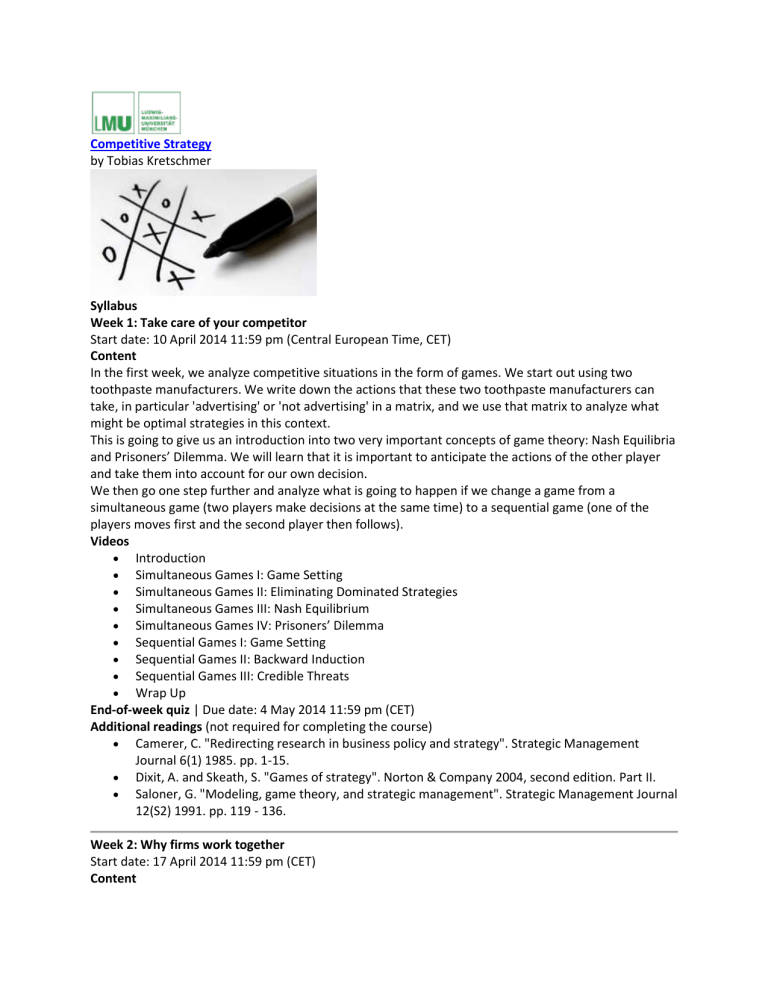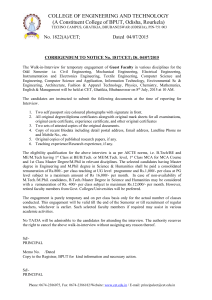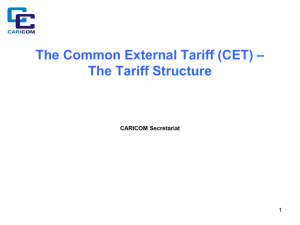Syllabus - s3.amazonaws.com

Competitive Strategy by Tobias Kretschmer
Syllabus
Week 1: Take care of your competitor
Start date: 10 April 2014 11:59 pm (Central European Time, CET)
Content
In the first week, we analyze competitive situations in the form of games. We start out using two toothpaste manufacturers. We write down the actions that these two toothpaste manufacturers can take, in particular 'advertising' or 'not advertising' in a matrix, and we use that matrix to analyze what might be optimal strategies in this context.
This is going to give us an introduction into two very important concepts of game theory: Nash Equilibria and Prisoners’ Dilemma. We will learn that it is important to anticipate the actions of the other player and take them into account for our own decision.
We then go one step further and analyze what is going to happen if we change a game from a simultaneous game (two players make decisions at the same time) to a sequential game (one of the players moves first and the second player then follows).
Videos
Introduction
Simultaneous Games I: Game Setting
Simultaneous Games II: Eliminating Dominated Strategies
Simultaneous Games III: Nash Equilibrium
Simultaneous Games IV: Prisoners’ Dilemma
Sequential Games I: Game Setting
Sequential Games II: Backward Induction
Sequential Games III: Credible Threats
Wrap Up
End-of-week quiz | Due date: 4 May 2014 11:59 pm (CET)
Additional readings (not required for completing the course)
Camerer, C. "Redirecting research in business policy and strategy". Strategic Management
Journal 6(1) 1985. pp. 1-15.
Dixit, A. and Skeath, S. "Games of strategy". Norton & Company 2004, second edition. Part II.
Saloner, G. "Modeling, game theory, and strategic management". Strategic Management Journal
12(S2) 1991. pp. 119 - 136.
Week 2: Why firms work together
Start date: 17 April 2014 11:59 pm (CET)
Content
According to economic theory, firms are generally competing against each other in a market. In reality, however, we see that firms are often fairly friendly to each other and cooperate with each other one way or another.
In the second week, we try to understand how this can be and why it is a good thing, at least for the involved firms. We figure out that firms work together if they interact repeatedly in the same market, e.g. if they play the same game repeatedly. We also see that a mechanism called commitment can help to achieve cooperation.
In terms of examples, we talk about streetlights for the Olympic Games, about the so-called Diamond
Cartel, and about the big airframe manufacturers. All of these are examples of potential competitors cooperating somehow.
Videos
Introduction
Reasons for Cooperation
Repeated Games I: Finite Repetition
Repeated Games II: Backward Induction
Repeated Games III: Infinite Repetition
Repeated Games IV: Factors Influencing Cooperation
Commitment I: Aggressive Commitment
Commitment II: Cooperative Commitment
Wrap Up
End-of-week quiz | Due date: 11 May 2014 11:59 pm (CET)
Case Study: De Beers and Beyond
Additional readings (not required for completing the course)
Cabral, L.M.B. "Introduction to industrial organization". MIT Press 2000. Chapter 8
Porter, P. "A study of cartel stability: the joint executive committee 1880-1886". Bell Journal of
Economics 14(2). pp. 301-314.
Week 3: The power of complements
Start date: 24 April 2014 11:59 pm (CET)
Content
The third week is all about complements. We introduce a formal definition of complements and discuss what they mean to us economically.
Later on, we have a look at strategies that are particularly interesting in markets with complementary products. We analyze why printers are fairly cheap and ink cartridges are quite expensive. We discuss why firms like to sell their products in a bundle and we learn how complementarity creates switching costs.
We learn that coordination among firms is important in the light of complementary products. Finally, we look at strategic partnerships as a powerful tool to align companies’ interests in this specific setting.
Videos
Introduction
Complements: Examples and Definitions
Strategies for Complements I: Generic Strategies
Strategies for Complements II: Positive Externalities
Complements and Cooperation I: Examples
Complements and Cooperation II: Strategic Partnerships
Wrap Up
End-of-week quiz | Due date: 18 May 2014 11:59 pm (CET)
Additional readings (not required for completing the course)
Porter, M. "Competitive advantage". Free Press 1985. pp. 416-422 / pp. 436-442.
Shapiro, C. and Varian, H. "Information rules: a strategic guide to the network economy".
Harvard Business School Press. pp. 159-162.
Yoffie, C. and Kwak, M. “With friends like these: the art of managing complementors”. Harvard
Business Review 84(9). pp. 88-98.
Week 4: How to enter a new market
Start date: 1 May 2014 11:59 pm (CET)
Content
We start the fourth week by focusing on the process of planning entry. We are mainly interested in how firms should choose the right market to enter. In this context, it is important to assess the attractiveness of a market and to analyze the entry barriers.
Subsequently, we discuss strategies firms can implement in order to enter a market successfully.
We also take a look on the other side, specifically at the firms that are already active in the market. They have a high interest to keep a potential entrant out of the market. Hence, we analyze strategies that they can opt to deter entry.
Videos
Introduction
Choice of Market I: Market Attractiveness
Choice of Market II: Structural Entry Barriers
Choice of Market III: Strategic Entry Barriers
Entry Strategies I: Commitment / Value Chain Reconfiguration
Entry Strategies II: Judo Economics / Niche Market
Entry Deterrence I: Structural Entry Barriers / Commitment
Entry Deterrence II: Limit Pricing / Predatory Pricing
Entry Deterrence III: Pre-Emption
Wrap Up
End-of-week quiz | Due date: 25 May 2014 11:59 pm (CET)
Additional readings (not required for completing the course)
Besanko, D. and Dranove, D. and Shanley, M. and Schaefer, S. "Economics of strategy". Wiley
2004, third edition. Chapter 9.
Cabral, L.M.B. "Introduction to industrial organization". MIT Press 2000. Chapter 15.
Mc Afee, P. and Mialon, H. and Williams, M. "What is a barrier to entry?". American Economic
Review 94(2) 2004. pp.461-465.
Week 5: Why worry about research & development
Start date: 8 May 2014 11:59 pm (CET)
Content
Research and development (R&D) is often said to be one of the key functions within a firm, even in industries that are not traditionally thought of as high-tech industries.
In the context of R&D, a number of important strategic questions come up consistently. In particular, how do firms choose the intensity and riskiness of their research activities, and how do R&D activities depend on the nature of the innovation and their position in the technological race towards an innovation. We have a closer look at these aspects throughout the fifth week.
Of course, many innovations come about through a stroke of luck or serendipity, but it would seem sensible to assume that the majority of innovations come about because their inventors actively strove towards this specific innovation.
Videos
Introduction
Stages of R&D
Types of Innovation
Incentives for Innovating I: Competitive Market
Incentives for Innovating II: Monopolist
Incentives for Innovating III: Monopolist with Threat of Entry
Innovation under Competition
Sleeping Patents
Wrap Up
End-of-week quiz | Due date: 1 June 2014 11:59 pm (CET)
Additional readings (not required for completing the course)
Cabral, L.M.B. "Introduction to industrial organization". MIT Press 2000. Chapter 16.
Angelmar, R. "Market structure and research intensity in high-technological-opportunity
industries". Journal of Industrial Economics 34(1) 1985. pp. 69-79.
Cabral, L.M.B. "R&D competition when firms choose variance". Journal of Economics and
Management Strategy 12(1) 2003. pp. 139-150.
Week 6: Design your product wisely
Start date: 15 May 2014 11:59 pm (CET)
Content
In week six, we focus on strategic aspects of product design. We start out with a phenomenon that is commonly known as the Bertrand Paradox. To put it simple, in a theoretical world two firms that sell the same products end up in perfect competition and make zero profits - a horrible scenario for any firm.
In reality, however, we see that there are some product related aspects that lower the competitive pressure and make it possible for firms to earn a substantial amount of money.
Firms do not have to take these aspects as given but can actively influence them to their favor. One aspect of particular importance is product differentiation. We study the difference between vertical and horizontal product differentiation, and see what firms can do about it.
Later on, we discuss some generic strategies for product design and pricing, namely cost leadership, differentiation and focus. We figure out the problems related to being stuck in the middle between these different strategies, and we look at ambidexterity.
Videos
Introduction
Bertrand Paradox I: Theoretical Model
Bertrand Paradox II: Adjusting Model Assumptions
Product Differentiation I: Introduction
Product Differentiation II: Horizontal Differentiation
Product Differentiation III: Vertical Differentiation
Pricing and Product Decisions I: Generic Strategies
Pricing and Product Decisions II: Stuck in the Middle
Wrap Up
End-of-week quiz | Due date: 8 June 2014 11:59 pm (CET)
Additional readings (not required for completing the course)
Cabral, L.M.B. "Introduction to industrial organization". MIT Press 2000. pp. 212-215.
Hotelling, H. "Stability in competition". Economic Journal 39(153) 1929. pp. 41-57.
Porter, M. "Competitive strategy". Free Press 1980. pp. 34-44.
Final exam quiz | Start date: 22 May 2014 11:59 pm (CET) Due date: 15 June 2014 11:59 pm (CET)








